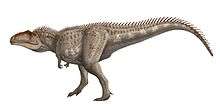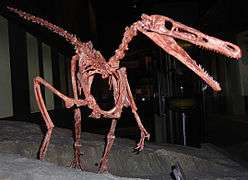Candeleros Formation
| Candeleros Formation Stratigraphic range: Cenomanian | |
|---|---|
| Type | Geological formation |
| Unit of | Neuquén Group |
| Underlies | Huincul Formation |
| Overlies | Lohan Cura Formation |
| Thickness | 300m |
| Lithology | |
| Primary | Sandstone |
| Other |
Conglomerate Eolian Siltstone Paleosol |
| Location | |
| Region | Neuquén Province |
| Country |
|
| Type section | |
| Named for | Candeleros Hill |
The Candeleros Formation (formerly known as the Candeleros Member of the "Rio Limay Formation") is a geologic formation that outcrops in Río Negro, Neuquén, and Mendoza provinces of Argentina. It is the oldest formation in the Neuquén Group and belongs to the Rio Limay Subgroup. Formerly that subgroup was treated as a formation, and the Candeleros Formation was known as the Candeleros Member.[1]
The type locality of the Candeleros Formation is Candeleros Hill in Neuquén province.[2] This formation unconformably overlies the Lohan Cura Formation, and it is in turn overlain by the Huincul Formation, also a unit of the Neuquén Group. The sediments of the latter are of lighter greenish and yellow colors and the boundary between the Candeleros and Huincul formations is easily recognizable.[3]
The Candeleros Formation is almost 300 meters thick in some sections. Overall, the formation represents an ancient braided river system, made up mostly of sandstones and conglomerates. There are also isolated sections that represent eolian (wind-blown) deposition, as well as siltstones deposited under swamp conditions. Paleosols (soil deposits) are common in some sections as well.[4]
Age
Era: Mesozoic
Period: Late Cretaceous
Faunal stage: early Cenomanian
Absolute Age: ~100 to ~97 mya
Vertebrate paleofauna


The Candeleros Formation has a very diverse fossil fauna, including:
- dipnoan fish (including Ceratodus argentinus)
- frogs
- Iguanodonts
- eilenodontine rhynchocephalians (including Priosphenodon avelasi)
- primitive snakes (including Najash rionegrina)
- several turtles (including 2 species of Prochelidella)
- rebbachisaurid sauropods (Limaysaurus and Nopcsaspondylus)
- titanosaurian sauropods (including Andesaurus)
- abelisaurid theropods (Ekrixinatosaurus and unnamed form[5])
- a carcharodontosaurid theropod (Giganotosaurus)
- a dromaeosaurid theropod (Buitreraptor gonzalezorum)
- an alvarezsaurid theropod (Alnashetri)
- a basal coelurosaurian (Bicentenaria)
- cladotherian mammals (including Cronopio dentiacutus)
Pterosaurs
Pteraichnus is found in Late Jurassic Strata of the Rio Limay group,[6] while substantial pterosaur remains are found on the La Buitrera Late Cretaceous strata.[7][8]
| Pterosaurs of the Rio Limay Formation | ||||
|---|---|---|---|---|
| Taxa | Presence | Description | Images | |
|
Ichnogenus: |
|
| ||
| Pterosaurs of the La Buitrera Formation | ||||
| Taxa | Presence | Description | Images | |
|
|
| ||
|
|
| ||
|
|
| ||
There are also several trackway sites and eggshells[1] known from the Candeleros Formation, including theropods, sauropods, ornithopods, and pterosaurs.
One of the most productive fossil localities in the Candeleros is known as La Buitrera and is now well known for producing many small tetrapod skeletons with three-dimensional preservation, although larger fossils, such as dinosaurs, are rare. Much larger dinosaur fossils have been recovered from other sites in the formation, however, including one of the largest carnivores known, Giganotosaurus. La Buitrera means, roughly, "the vulture-roost"; the genus Buitreraptor, a small bird-like dinosaur that must have been a predator of small vertebrates and possibly a scavenger was named after this.
See also
Footnotes
- 1 2 Sánchez et al. (2006)
- ↑ Wichmann (1929)
- ↑ Leanza et al. (2004)
- ↑ Leanza et al. (2004), Sánchez et al. (2006)
- ↑ "Small-sized abelisaurid (Theropoda: Ceratosauria) remains from the Upper Cretaceous of northwest Patagonia, Argentina". Cretaceous Research. 62: 18–28. doi:10.1016/j.cretres.2016.02.001.
- 1 2 3 4 5 Lockley, M.; Harris, J.D.; and Mitchell, L. 2008. "A global overview of pterosaur ichnology: tracksite distribution in space and time." Zitteliana. B28. p. 187-198. ISSN 1612-4138.
- 1 2 Haluza, A. Y Apesteguía, S, Pterosaur remains (Archosauria, Ornithodira) from the early Late Cretaceous of "La Buitrera", Río Negro, Argentina, Jornada; XXIII Jornadas Argentinas de Paleontología de Vertebrados; 2007
- 1 2 Alejandro Haluza, Juan I. Canale, A PARTIAL PTEROSAUR ULNA FROM THE CANDELEROS FORMATION (NEUQUÉN GROUP), LATE CRETACEOUS OF ARGENTINA, Historia Natural 2013
References
- Leanza, H.A.; Apesteguia, S.; Novas, F.E. & de la Fuente, M.S. (2004): Cretaceous terrestrial beds from the Neuquén Basin (Argentina) and their tetrapod assemblages. Cretaceous Research 25(1): 61-87. doi:10.1016/j.cretres.2003.10.005 (HTML abstract)
- Sánchez, Maria Lidia; Heredia, Susana & Calvo, Jorge O. (2006): Paleoambientes sedimentarios del Cretácico Superior de la Formación Plottier (Grupo Neuquén), Departamento Confluencia, Neuquén [Sedimentary paleoenvironments in the Upper Cretaceous Plottier Formation (Neuquen Group), Confluencia, Neuquén]. Revista de la Asociación Geológica Argentina 61(1): 3-18. PDF fulltext
- Wichmann, R. (1929): Los Estratos con Dinosaurios y su techo en el este del Territorio del Neuquén ["The dinosaur-bearing strata and their upper limit in eastern Neuquén Territory"]. Dirección General de Geología, Minería e Hidrogeología Publicación 32: 1-9.